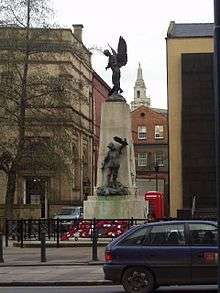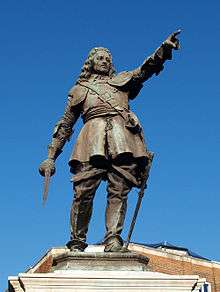Henry Charles Fehr
Henry Charles Fehr FRBS (4 November 1867 – 13 May 1940) was a British monumental and architectural sculptor active in the late nineteenth and early twentieth centuries.

Fehr was born in Forest Hill in south-east London. His family was of Swiss origin and an ancestor was a President of Switzerland. Henry Fehr spent many of his formative years around East London, and lived in Leyton and later in South Kensington.
He studied at the City of London School and at the Royal Academy Schools from 1885 where he won medals and a Scholarship. From 1889 to 1893 he was the studio assistant to the sculptor Thomas Brock, and also trained in the studio of Horace Montford. Fehr first exhibited at the Royal Academy in 1887. He was an original member of the Royal British Society of Sculptors in 1904, and later was elected a Fellow. His monumental works include The Cenotaph in Leeds, the Queen Victoria Memorial in Hull (1903), the decorations on the City Hall in Cardiff, sculptures on the Middlesex Guildhall in Parliament Square, as well as a number of war memorials and portrait busts.[1]
In 1898 he made a frieze of coloured bas-relief with scenes from the Wars of the Roses for Wakefield County Hall. For the architect Charles Fitzroy Doll he produced four life-size sculptures of British Queens for the Hotel Russell in London's Bloomsbury area.[1] Fehr's best-known work, Perseus Rescuing Andromeda (1893), is located outside on the right hand balcony of Tate Britain in London.
His studio was No 6 at the Fulham Road Studio, then located at 12–14 The Avenue, Fulham Road, London. Others who had studios there included John Singer Sargent, Edward John Poynter, Charles Edward Hallé, Sir Joseph Edgar Boehm, Alfred Gilbert and Edward Onslow Ford.[2]
With his wife, Rose, he had two sons, the artist Arthur Henry Fehr (1897–1990) and Frederick C Fehr.[3]
Henry Charles Fehr died in London on 13 May 1940.
Gallery
 Statue of John Hampden in Aylesbury Buckinghamshire
Statue of John Hampden in Aylesbury Buckinghamshire- Statues of British Queens on the Hotel Russell by Fehr
- Welsh Dragon on top of the dome of Cardiff City Hall (1904)[4]
- Eastbourne War Memorial (1920)[5]
References
- Fehr in Tate Online
- John Singer Sargent's Fulham Road Studio
- Margaret Macculloch & David Hall Family History c1150-2009
- "Welsh Dragon by Henry Charles Fehr". The Victorian Web. Retrieved 30 May 2014.
- Historic England. "Eastbourne War Memorial, Memorial Roundabout, South Street, Eastbourne, East Sussex (Grade II) (1441521)". National Heritage List for England. Retrieved 1 January 2019.
External links
| Wikimedia Commons has media related to Henry Charles Fehr. |